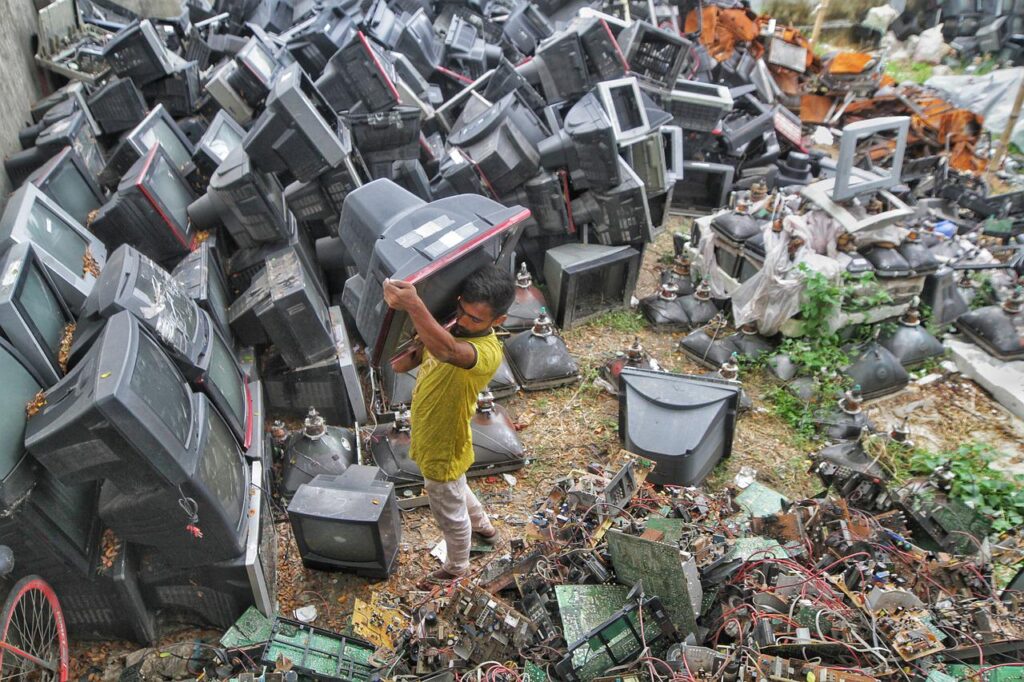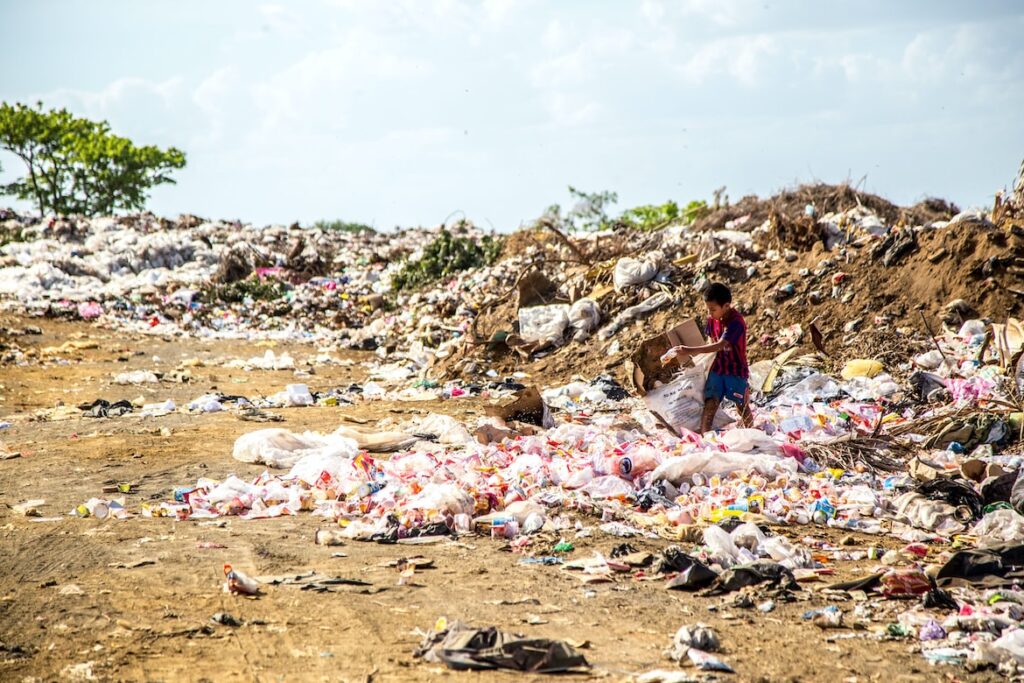- A Love Story of the Streets with Gutka and Pan Masala Wrappers - March 24, 2023
- NCR Draft Plan 2041: Why are citizens worried and How to Help? - March 18, 2023
- Know How to Calculate your Carbon Footprint in 9 Easy Steps - March 15, 2023
E-Waste is basically all the used electronic gadgets and appliances that have been discarded by people, often because the gadgets have neared their usage life or have broken and are no longer operable. From mobile phones to laptops, fans, television, printers and everything that works on electricity has a life, and is thrown away at one point of time.
In the era of fast technological advancements, the electronic products are coming up with newer modified versions so much so that the previous models become obsolete and are discarded as waste, them probably ending up in the landfills or in the bottom of the oceans.

In 2019, 53.6 million tonnes of electrical waste were collected worldwide, of which only 17.4 % were recycled. Electrical waste not dealt with by other means, is sent to third world countries where it is partially dismantled, incinerated or thrown into the sea under conditions which are harmful to human health and the environment.
One question that might be bothering you is that how is e-waste that is ending up on the landfills having a harmful impact on humans? Let us explain!
impact of e-waste on human health
According to a report by WHO, around 12.9 million women working in the informal waste sector are potentially exposed to toxic e-waste which puts them and their unborn children at risk. More than 18 million children and adolescents, some as young as 5 years of age, are involved in the informal industrial sector putting them at the exposure of highly toxic chemicals such as lead and mercury which hampers their intellectual ability.

Communities that reside near e-waste recycling facilities are at an equal risk of exposure to the contaminants released in the process. A team led by researchers of WHO have found a plausible explanation between e-waste exposure and thyroid disfunction, adverse birth outcomes, behavioral changes and decreased lung function.
With a recent shift in buying choices of customers where majority of the people tend to buy cheap and low quality products with lower life, there is a risk of greater impact on the health of workers in the informal sector. The electronic gadgets contain chemicals such as Lead, Cadmium and Chromium which when burned release toxic fumes into the environment. According to the Institute of Physics, the fumes when inhaled by the workers and nearby residents cause severe damage to human blood, kidney and the nervous system.
The risk posed by the collection of e-waste for recycling is of great intensity and harms the workers. Post collection, most of the countries follow primitive ways of recycling such as burning cable to extract valuable metals of gold and copper from the e-waste. The process releases harmful chemicals and the most affected are the children working in the informal section.
Impact of e-waste on environment
The United Nations Environment Programme (UNEP) estimated in a 2015 report “Waste Crimes, Waste Risks: Gaps and Challenges in the Waste Sector” that 60-90 per cent of the world’s electronic waste, worth nearly USD 19 billion, is illegally traded or dumped each year.
With a plethora of electronic waste items being disposed daily on the landfills, toxic chemicals are being released which impact the earth’s soil, water and air. Contamination of air occurs when e-waste is informally disposed by dismantling, shredding or melting the materials, releasing air pollutants that are not only harmful to the environment but also to the human health.

Computers and most electronics contain toxic materials such as lead, zinc, nickel, barium, and chromium.
Higher value materials, such as gold and silver, are often removed from highly integrated electronics by using acids, soldering, and other chemicals, which also release fumes in areas where recycling is not regulated properly. The negative effects on air from informal e-waste recycling are most dangerous for those who handle this waste, but the pollution can extend thousands of miles away from recycling sites.
E-waste can be toxic, is not biodegradable and accumulates in the environment, in the soil, air, water and living things.
How To Dispose e-waste properly?
A UN report suggests that lowering the amount of electronics entering the waste stream and improving end-of-life handling are essential for building a more circular economy, where waste is reduced, resources are conserved and are fed back into the supply chain for new products.
E-waste can be properly disposed of through recycling, reusing, refurbishing, and reselling. So what can you do to reduce your e-waste footprint? Let us have a look at some solutions-
Send the electronics items for recycling

Check with the local government on laws and regulations guiding ethical and safe disposal of these waste. In India, there are 472 registered e-waste dismantlers/ recyclers that are accredited for handling e- waste as per the authorisation of SPCBs/ PCCs under E-Waste (Management) Rules, 2016. You can check for the nearest recycler in your area and handover your e-waste to them!
Donate old phones, laptops/tablets to the underprivileged
With the donation of electronics, some of the e-waste disposed can actually be reused, and by doing this, one can reduce pollution caused by e-waste and also give access to the underprivileged people who would not otherwise have access to these devices.

In this digital era, every piece of knowledge is available online and children who do not have the facility to attend a school can be taught how to use such devices.
Cashify is one such platform where you can donate your old working phones/laptops/tablets and they ensure that the items collected are refurbished provided to the children in need.
Sell/ Exchange your old and used e-products
Well if you want to earn and also leave a good impact on the planet, the best way is to either sell your old electronic gadgets to electronic vendors offline/online or exchange those products while buying a new one. All the e-commerce platforms offer exchange services whether you’re buying a new mobile phone, laptop, television, or any such gadget. In exchange for your old gadget, a particular amount is deducted from the price of the new item.

If you’re buying offline, enquire the store if they would be willing to exchange your old product for a new!
A new vision for the production and consumption of electronic and electrical goods is needed. It is easy for e-waste to be framed as a post-consumer problem, but the issue encompasses the lifecycle of the devices everyone uses. Designers, manufacturers, investors, traders, miners, raw material producers, consumers, policy-makers and others have a crucial role to play. From reducing waste to retaining value within the system to extending the economic and physical life of an item, as well as its ability to be repaired, recycled and reused, everyone has a part in the process.
It’s high time the problem is addressed by the concerned authorities and strict laws are put into place. The health of the workers and the planet should be at the utmost priority over profits and greed. The question is, are we all willing to take the first step and do our part?







